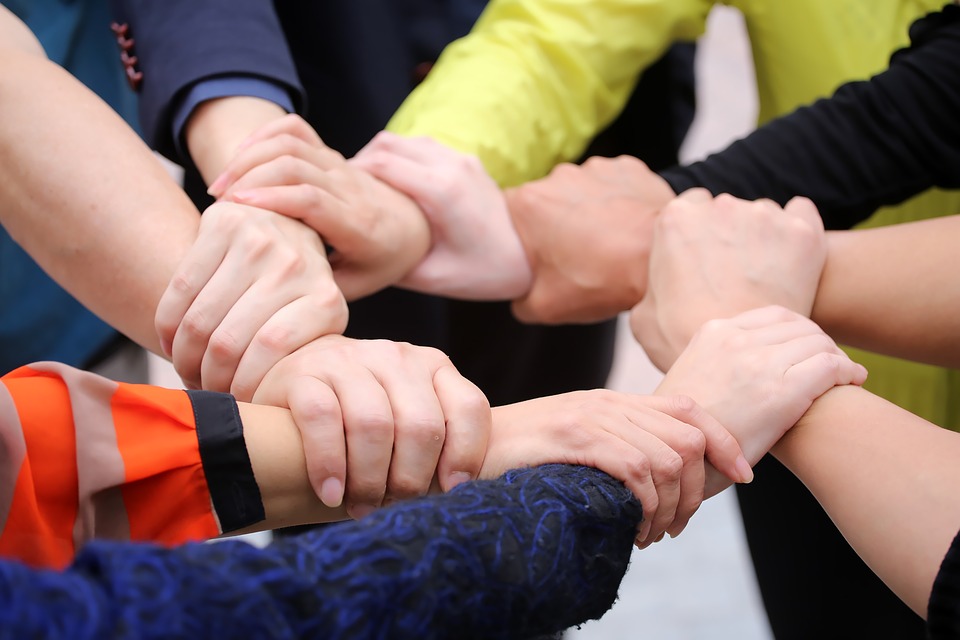
Friday Night
THE BIG PICTURE Zoominar continues this Tuesday, b”H. You can register at any time by writing to [email protected].
IT’S TIME TO talk about achdus again. This is the parsha of the reunion of the entire family after turning around from the brink of collapse. Even the Maftir is about it. So often that is how it works.
We first get wind of the importance of unity when Ya’akov is lying down to sleep the night he dreams of the ladder. He placed 12 stones, obviously one for each of the future tribes, around his head as kind of a security measure. Then he said for some reason, “If these stones become one, then I will know that nothing bad will come out of me.” And miraculously, they did become one.
Clearly the unity of Ya’akov’s family was on his mind even before he married. True, every parent wants their children to get along with each other, and gets pleasure from seeing it happen. But how many think about it so far in advance? Clearly it had been Ya’akov’s intention to build more than family, but what?
Let’s approach that question from a different direction. What would it take to make achdus a reality for the Jewish people? Well, what stands in the way of it? That’s easy, two Jews, three opinions. Two million Jews, three million opinions, etc. That’s a lot of opinions, especially if many of them oppose one another. Somehow people would all have to be of the same opinion, or close to it.
It has been said that a Jew once told an enemy, “If you want to destroy us, just go home. We’ll do it for you through our own in-fighting. But if you want us to band together, then attack us. Then we unify and become stronger.” Two people running for their lives quickly become allies.
Maybe that is part of the hidden agenda of the War of Gog and Magog. It will be against the Jews, even the ones who don’t think it will be against them. In the end, it will be to eliminate the enemies of the Jewish people on the way to the final redemption. But in-between, maybe it will be to create a common cause to unify Jews all over the world. The Holocaust certainly unified a lot of Jews, but is that the way we want to attain achdus?
Shabbos Day
THERE IS A better way to join the thinking of people, and we witnessed it at Har Sinai. That’s when the Jewish people reached the perfect achdus of k’ish echad b’leiv echad—like a single person with a single heart. There was something about the Master of the Universe revealing Himself and talking to everyone there, that made people forget every last selfish desire they had and, to think only about truth.
But even that didn’t last too long. Once the prophecy ended, the Jewish people lost their achdus. The Erev Rav instigated the golden calf. They drew three million stragglers to it, and left the rest of the nation to hide in their tents wondering what was going to happen next.
And even though God imbued Torah with His presence, it wasn’t enough to cause achdus. On the contrary, if anything, Torah has been such an ongoing source of machlokes—argument. Sometimes the disagreements are only technical and do not impact achdus much. Other times they have torn communities apart, resulting in countless break-off groups.
Something is missing.
The question is, what?
It’s like making a cake, sort of. You can have all the ingredients right except for one, and the cake still turns out wrong. It might taste okay, but it is still missing an ingredient (or two) to make it right.
A good chef knows exactly what it is.
Do the Jewish people?
Does anyone really care enough?
We should. After all, the world seems to be coming apart at the seams. True, lots of people prefer this downward direction and, some are spending a lot of money to promote more chaos. But at the end of the day, as protected as they think they are, chaos is bigger and stronger than all of us.
And as much as the chaos promoters may think they are the cause of the chaos, they are not. They are just the means to make it happen or get worse. The chaos is a result of the lack of achdus of the Jewish people, as Ya’akov Avinu understood. He wasn’t just building a nation. He intended to keep Creation in business and, it’s why the future achdus of his family was such a priority for him.
What does one have to do with the other, you may be asking? If you understand the key ingredient to achdus, then the question will answer itself.
Seudah Shlishis
IT’S SUCH A simple word, and yet it means the world to the world. The word is da’as, and simply means knowledge. But there is knowledge, and then there is knowledge, so there is da’as, and there is da’as.
The first da’as refers to the Aitz HaDa’as Tov v’Ra, the Tree of Knowledge of Good and Evil. The second da’as refers to the Aitz Chaim, the Tree of Life. The difference between the two is huge. The Aitz HaDa’as caused death, and the Aitz Chaim led to eternal life.
And lest one think that Aitz Chaim refers to all of Torah, and the Aitz HaDa’as to every other kind of knowledge, it’s not true. According to Kabbalah, the Aitz HaDa’as includes anything that deals with good and evil, holy and profane, pure and impure, etc., and that includes most of Torah.
So what does represent the Aitz Chaim in the world? Kabbalah. Why? Because it deals principally with a level of Creation on which evil cannot exist. The root of evil may already be present on this level, but it is still only a potential, and the root is still holy.
It’s like the difference between Yitzchak and Eisav. They both came from the same soul light, but they were worlds apart. Yitzchak was what the light of Gevurah looks like when it is still unaffected by the darkness of this world. Eisav was what this light looks like when it has been blemished by the physical world.
Even the Aitz HaDa’as is really just the light of the Aitz Chaim after it has descended into this world of filtered divine light. As powerful and aggressive as evil seems, it is really just what happens when good is reduced and a spiritual vacuum results. If you go high enough up in the spiritual realm, the Aitz HaDa’as merges with the Aitz Chaim, and that is the real source of achdus.
That’s why the prophet talks about the Messianic Era in terms of da’as. He mentions that God said that, at that time He will fill the world with da’as, and peace will reign forever. He doesn’t mean that we’re all going to become mathematicians or scientists. He means we’re all going to become kabbalists…like we did at Mt. Sinai to become unified like a single individual. It happens automatically when the revelation of God is intense enough.
It’s not that at Mt. Sinai we all started learning Zohar. We didn’t have to. We were already living the reality that the Zohar tries to help us create post-Sinai. We witnessed the Divine Presence with our own eyes. We heard the Divine Voice with our own ears. We saw the miracles that occurred at that time. We reached the level of Aitz Chaim just by being part of the experience, which is why we regained immortality again.
Chanukah is over, but this is what it tried to give us while it was here. It is access to the Ohr HaGanuz, and that is the light of the Aitz Chaim. Now we’re about to begin Shov’vim with Parashas Shemos, b”H. We will build hopefully, on what we began achieving during Chanukah. More on this next week, b”H.
Melave Malkah:
AFTER REEDITING AND republishing The Big Picture, b”H, I decided to do the same to another flagship book, Redemption to Redemption: The Very Deep & Intricate Connection Between the Holidays of Purim and Pesach.
It is now done and in the Amazon store, and for a limited time, It’s available in Paperback, Hardcover, and PDF formats with a 25 percent discount through me at [email protected], and in Kindle format without the discount through Amazon. The following is the introduction to the book.
The Talmud has a question.[1] In a normal Jewish year there is only one month of Adar, on the 14th day of which Purim is celebrated. In a Jewish leap year however, an entire month is added called Adar Sheini—Second Adar. The Talmud wants to know therefore in which Adar Purim should be celebrated?
There is an argument for each Adar. First, there is the idea of ain ma’avirin al hamitzvos, which basically means that we don’t like to push off a mitzvah. Mitzvos are too valuable to pass up, so we like to do them first chance we have:
You shall guard the matzos… (Shemos 12:17)
Rebi Yoshia said: Don’t read “the matzos,” but “the mitzvos,” meaning the commandments, as if to say: Just as you must be careful not to allow the matzah to become leaven, so too must a mitzvah not become “leaven” by waiting too long to perform it. If a mitzvah comes your way, perform it immediately. (Rashi)
Why push Purim off until Adar Sheini if you can celebrate it in Adar Rishon, the first Adar?
On the other hand, there is semichas geulah l’geulah, putting two redemptions close together. In a non-leap year, Purim falls out thirty days before Pesach:
From Purim to Pesach is 30 days. (Sanhedrin 12b)
If Purim is in Adar Rishon in a leap year, then Purim will end up being sixty days before Pesach. Why distance the two holidays when they can be kept close together by celebrating Purim in Adar Sheini?
We know from practice what the Talmud decided. Apparently in this case we overlook the seemingly all-important principle of ain ma’avirin al hamitzvos and celebrate Purim in Adar Sheini, keeping it thirty days before Pesach. The question is, why?
The Talmud says something else that, on the surface, seems incidental but which may in fact allude to the answer:
From Purim to Pesach is 30 days. From Purim, one should start learning the laws of Pesach. (Sanhedrin 12b)
Who learns Hilchos Pesach while celebrating Purim? True, the Talmud specifies learning the laws of a holiday thirty days in advance,[2] but couldn’t it be 29 days in the case of Purim? It’s such a busy day…
No, and not only because of the enactment. There is a reason why we want Purim and Pesach close together. They are intricately connected, and to such an extent that properly celebrating Purim is to prepare for Pesach. If anything, the Talmud is indicating, Purim is the threshold to the freedom of Pesach. The starting point to understanding how is knowing that, when it comes to Purim and Pesach, nothing is as it seems to be.


